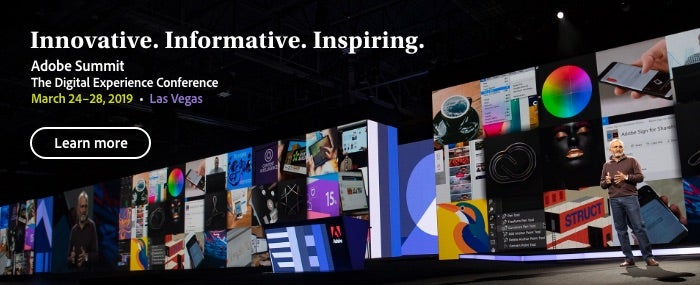How to Create Emails Your Customers Actually Want to Open
Drive engagement and loyalty by re-invigorating your email marketing program.

Emails are a cost-efficient and reliable marketing tactic for a good reason — they’re proven to drive customers engagement and business revenue. But conventional emails also face increased competition for customers’ attention — not just from other emails, but also from every other media channel. And, truthfully, churning out emails can become a little routine, for both marketers and customers.
But that needs to change. At Adobe Summit 2018, both Kiril Rachev, principal consultant for Adobe Campaign, and Michael Sciano, product marketing manager for Adobe Campaign, evangelized how marketers need to be laser-focused on creating email marketing programs that surprise and delight their customers. Here are their tips — and some real-world examples from brands — for how to achieve this and create emails that customers actually look forward to opening.
1. Assess your email maturity model
Before talking about future email campaigns, it’s useful to determine the maturity of your current emails, Michael said, which can be categorized into three areas:
- Classic emails. These include batch and blast emails, welcome campaigns and personalized emails. These are foundational emails that every brand should deliver.
- Dynamic emails. These emails are focused on abandoned cart campaigns, automated remarketing, and cross-channel integration.
- Contextual emails. This level of email is usually related to customer journey advancement and includes content based on open time and context.
Even though these email types are rated with different levels of maturity, a holistic email program would include emails from each of these categories. Everyone needs a foundation of classic email campaigns, while the dynamic and contextual emails are very effective for driving conversion and increasing revenue. If you’re not sure where your organization falls on the email maturity spectrum, take this self-assessment for a quick way to find out.
2. Use personalization to drive engagement and brand loyalty
At the foundation of every single marketing activity is the idea of talking to your customers in a very personable way, Kiril said. It’s not just using the customer’s name, but it’s also using contextual information that makes the email effective — it engages them so they will open your emails and read the content.
“The more personalization you apply to your emails, the better revenue you can generate out of those efforts,” he said.
And, as customers’ expectations increase, efforts to deliver more personalization — starting with the first customer interaction — must do the same. Welcome emails are a perfect place to start; it’s where the conversation with the customer begins, Michael said.
Garmin has a welcome email for new subscribers that introduces customers to what it means to be part of the email program.
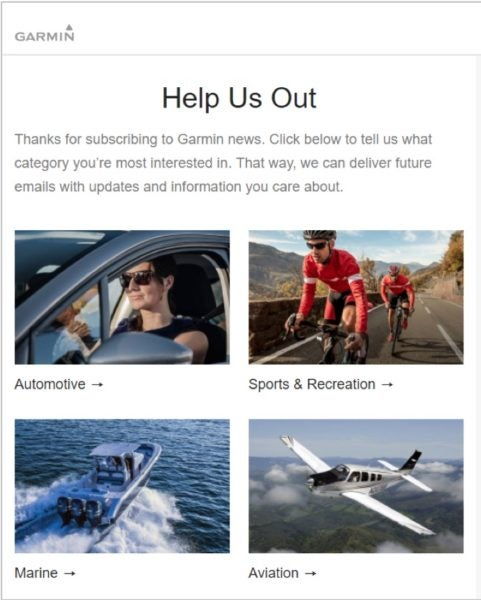
Garmin asks customers to provide information about their preferences, whether they’re interested in automotive, sports, recreation, aviation, or other areas. Customers are taken to Garmin’s Adobe Campaign landing page where they can indicate their interests. Garmin can use that information later to target and segment.
Subaru offers a similar welcome page, but asks customers what online magazines they would like to subscribe to, whether it’s about gears, gear events, or updates on product lines.

Ulta offers an example of a personalized, contextual email. Using technology from Adobe partner Liveclicker, Ulta can deliver an email that tells a customer their specific points balance and how close they are to the next award. This is very convenient and is delivered with real-time information.
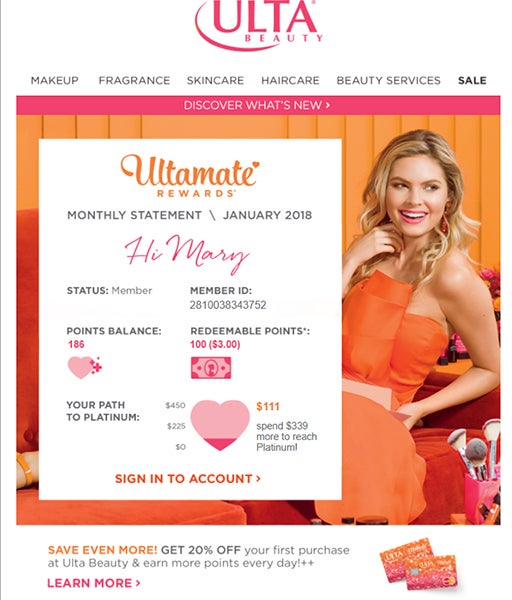
Even if you’re not Garmin, Subaru, or Ulta, these examples show how companies can use email to make customers feel seen and understood.
3. Strengthen the customer journey with relevant interactions
Personalized and relevant emails can increase conversion rates as much as four times, Michael said. To make emails relevant, you need to understand your customer journey, so you can reach customers with the right content and the right message at the right time.
Verizon provides a stellar example of a just-in-time email, Michael said. Michael had just purchased a phone from Verizon. He immediately received an activation email from Verizon walking him through the process and telling him what he needs to know about his new phone, what accessories and insurance were available, and his contract information.
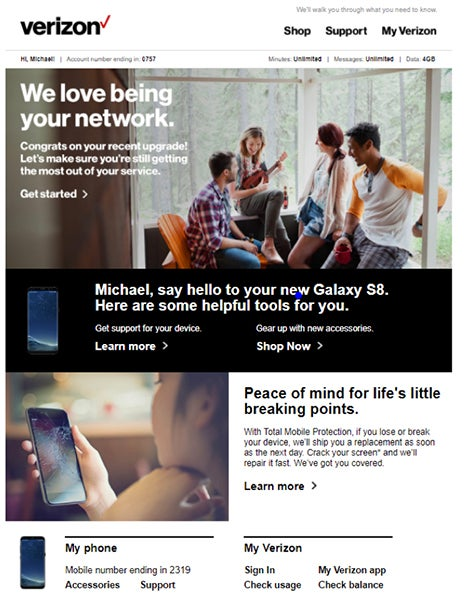
“Verizon is able to understand and see my interactions as I’m activating that new phone and then trigger off that email,” he said.
On their birthdays, customers often receive birthday emails containing a reward offer. Marketers should make sure the promotional offer is impactful and relevant to the customer.
“What does your subscriber really want — what could you surprise and delight them with?” Michael asked. For his birthday, Marriott offered a free night’s stay. As a frequent traveler, this was a thoughtful, useful gift.
Sephora has identified the average purchase cycle for its different products and sends customers a reminder email once they need to replenish a past purchase. This engages their customers in another conversion by linking them to online shopping and providing directions to the closest Sephora location.
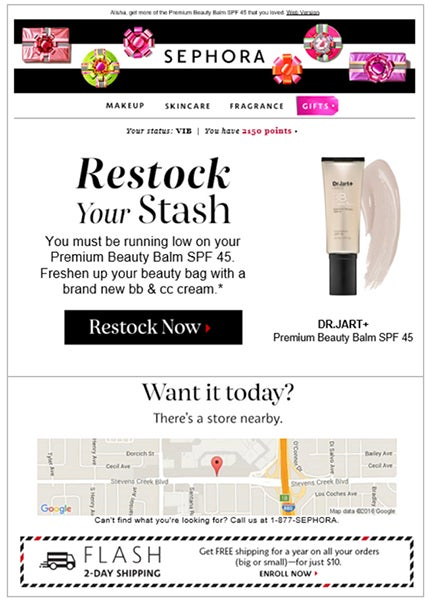
What Verizon, Marriott, and Sephora did is simple to replicate, said Kiril. Map out your customer’s journey and look throughout that journey to build relevant communications and interactions with them. Create these start-to-finish experiences, get the data to support them, and tailor the message.
“It doesn’t have to be complicated to be efficient,” Kiril said.
4. Orchestrate multiple channels to add context to emails and deliver a better experience
Customers don’t just interact with brands through email. They go to websites, social media, and apps. But some brands have silos within their organizations, so their marketing efforts aren’t always in sync, and in some cases, may overlap. Being able to manage all of these different channels in one place means marketers don’t have to jump from tool to tool, stitching together a multi-channel journey, Michael said.
Taylor Guitars is a standout example of effectively using a cross-channel approach, Michael said. Featured artists sometimes play live gigs on Facebook Live. Taylor Guitar sends email subscribers an email encouraging people to join Facebook Live and watch the show. It’s a great example of using one channel (email) to drive engagement with another channel (social).
Another example is Oregon Community Credit Union (OCCU), which had a goal last year of getting 400 new customers when it launched a new program for pre-approved credit cards. OCCU relied on a marketing program that created personalized emails containing information about credit card offers along with personalized URLs that migrated the information straight into a personalized landing page. On that page, the customer received credit limit and interest rate information predetermined from a third-party credit rating agency data. The campaign also included direct mail.
“All these different channels were talking to each other and complementing each other,” Kiril said. The result of all this personalization was that OCCU exceeded its goal by 236 percent.
OCCU’s effort illustrates the importance of cross-channel integration and how this approach can enhance email marketing programs. Use every tool in your toolkit — your partnerships, social media, and all your marketing channels — to develop a unique approach for delivering relevant and helpful email messages to customers.
As a marketer, you’re already making the effort to build emails. That time should be spent crafting messages that result in clicks and more conversions. As these brands illustrate, creating effective emails requires the right strategy and tools to drive more context and personalization. And the investment is worth it if it means your brand’s messages won’t end up in someone’s junk folder.
Watch the full presentation at Summit Online, and see all the news announced at Adobe Summit here.
